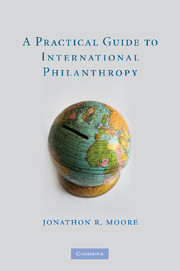Book contents
- Frontmatter
- Contents
- Preface
- Who should read this book
- A Practical Guide to International Philanthropy
- 1 Introduction
- 2 Fundamental concepts relating to charitable organizations
- 3 U.S. legal framework governing charitable organizations
- 4 U.S. legal constraints
- 5 Constraints on cross-border philanthropy
- 6 Why create a foreign charity?
- 7 Picking a jurisdiction
- 8 Establishing a foreign charitable foundation
- 9 Representative structures
- 10 Further resources
- Glossary of terms
- Appendices
- Index
6 - Why create a foreign charity?
Published online by Cambridge University Press: 04 August 2010
- Frontmatter
- Contents
- Preface
- Who should read this book
- A Practical Guide to International Philanthropy
- 1 Introduction
- 2 Fundamental concepts relating to charitable organizations
- 3 U.S. legal framework governing charitable organizations
- 4 U.S. legal constraints
- 5 Constraints on cross-border philanthropy
- 6 Why create a foreign charity?
- 7 Picking a jurisdiction
- 8 Establishing a foreign charitable foundation
- 9 Representative structures
- 10 Further resources
- Glossary of terms
- Appendices
- Index
Summary
The bias in U.S. law against private foundations
As has been suggested herein, once a potential philanthropist sets out to establish a charitable organization, he or she will quickly learn that it will be far easier to create a public charity rather than face the regulatory burdens and constraints of creating and maintaining a private foundation. Fundamentally, the entire private foundation regulatory regime can be avoided by broadening support for the organization so that at least 35 percent of the support each year comes from the general public. Moreover, founders frequently come quickly to the conclusion that the compliance efforts that are entailed in equivalency determinations and expenditure responsibility on grants to nonpublic charities can be avoided by funding grantees that are already qualified as public charities.
The burdens and complexities of the U.S. regulatory regime governing private foundations have had the predictable effect of discouraging philanthropists from establishing private foundations. Among the more visible manifestations of this effect is the rise of donor-advised funds. According to its recent survey of donor-advised funds, The Chronicle of Philanthropy found that the assets of 103 of the largest such funds grew by 25 percent in 2007, reaching a staggering $23.3 billion. The amount of money distributed to charities from donor-advised mutual funds also jumped significantly, increasing 24 percent to $4.2 billion in 2007.
Sooner or later, all of the gifts transferred to such funds will flow to public charities.
Information
- Type
- Chapter
- Information
- A Practical Guide to International Philanthropy , pp. 67 - 72Publisher: Cambridge University PressPrint publication year: 2009
